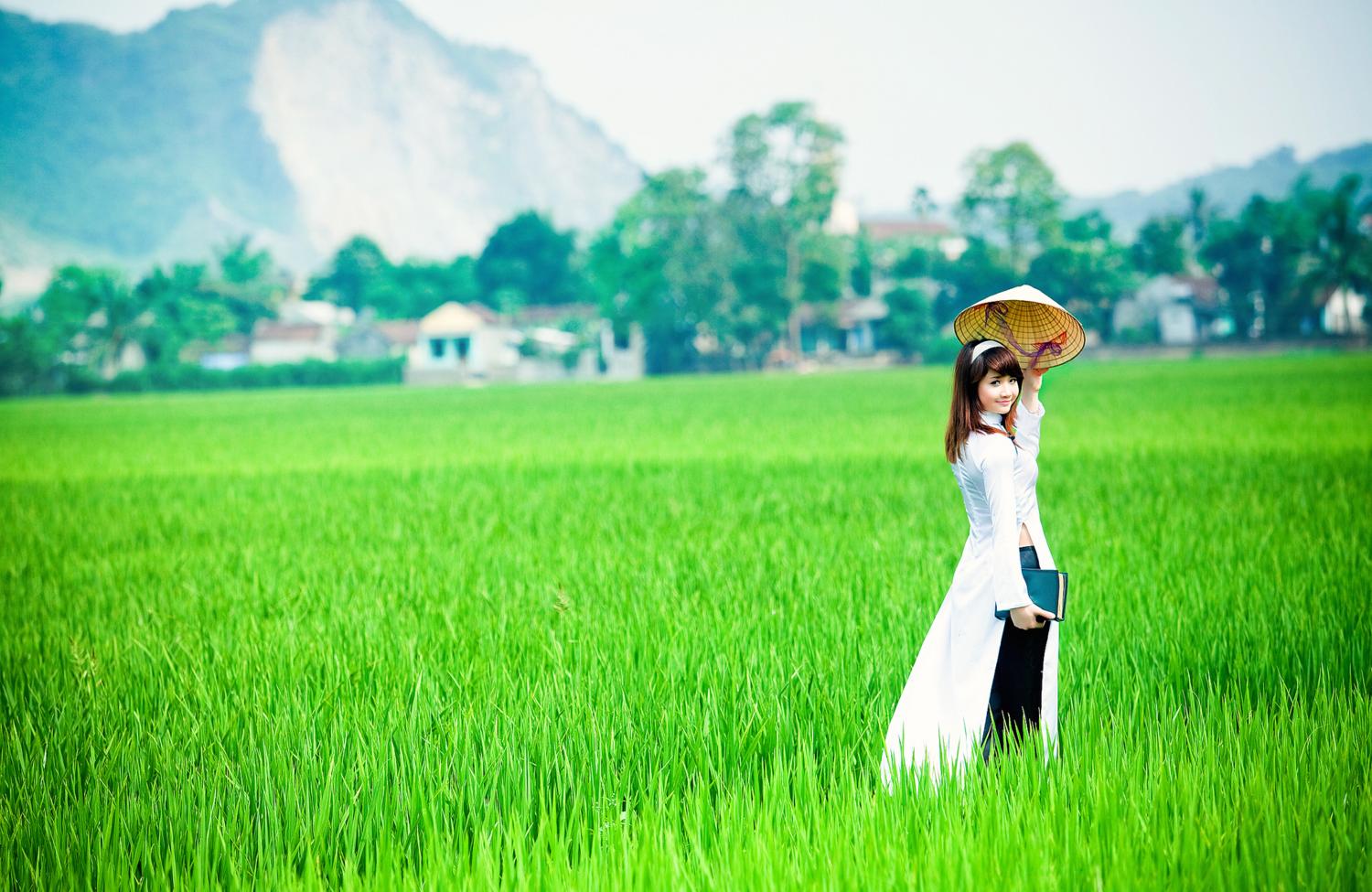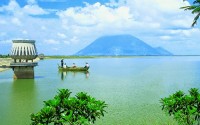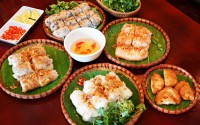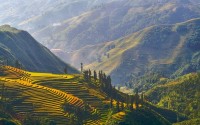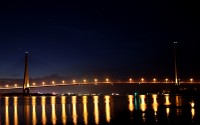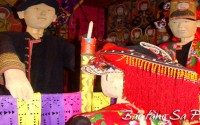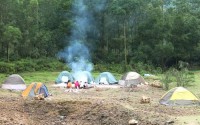Vietnam Fact file and travel tips
Our specialists have local knowledge about the top vietnam places to visit. Find out where we recommend for your next tailor-made trip.
The Socialist Republic of Vietnam , shaped like the letter “S” with 330,991 sq.km of land area and 1,000,000sq.km of seawater and there are nearly 4,000 small and large islands. Vietnam lies in the eastern part of the Indochina peninsula and shares borders with China to the north, Laos and Cambodia to the west and the East Sea and Pacific Ocean to the southeast.
With a population of over 89 million and homeland of 54 ethnic groups (the vast majority of population is Vietnamese), Vietnam is the 13th most populous country in the world.
The climate of Vietnam varies considerably from region to region. Although the entire country lies in the tropics and subtropics, local conditions vary from frosty winters in the far northern hills to year-round, subequatorial warmth in the Mekong Delta.
Vietnam is an agricultural civilization based on wet rice cultivation with ancient Dong Son culture as one of its defining aspects. The major stimulation of Vietnamese culture’s development comes from indigenous factors, with Chinese serving to further enrich it. Through history, Cham culture and the cultures of other minority ethnic groups in Vietnam have been integrated with Vietnamese culture in correlated effects. The official spoken and written language of Vietnam is Vietnamese.
Vietnam has a lot of festival in all year round. Tet (Vietnamese New Year), the biggest festival in the calendar, which falls in late January or early February.
Vietnam has it all. Go expecting the unexpected, be ready for an adventure as much as holiday, and Vietnam will deliver.
Weather
Vietnam’s elongated shape stretching from the tropics to the subtropics zone accounts for the varied climate in the country. Vietnam is an year round destination, when one part of Vietnam is cloudy and rainy, there are other parts of the country that can be sunny and warm North Vietnam enjoys 4 seasons, meanwhile Central and South have 2, rain and dry seasons. Heat and humidity are typical weather of Vietnam.
Weather is often a determinant factor in travel planning. Since Vietnam covers several climatic zones, the weather can change significantly traveling north to south. The chart below provides average daily minimum/maximum temperatures in degrees Celsius and average rainfall in millimeters. Please refer to this chart and our suggested packing list later in this document when deciding what to pack for your trip.
Clothing
Light, comfortable, easy to launder clothing is recommended. Winter months in Hanoi and rainy season in the central region can get cool so a sweater or light jacket will come in handy. Good walking shoes and sandals that can be easily removed are recommended especially when visiting temples and people’s homes. Ensure you have suitable clothing packed for visiting temples and pagodas that you can cover up with. E.g. Shirts and long pants. No dresses, shorts, singlets, string tops or revealing clothing should be worn to temples and pagodas.
What to Pack
Vietnam is generally a casual country by western standards although people do like to dress in their Sunday best whenever the opportunity arises therefore simple and casual clothes are appropriate for almost any occasion.
The year round heat and humidity in the south, especially Ho Chi Minh City makes lightweight quick dry clothing the most appropriate. The north and central highlands get cool enough for sweaters or light jackets for much of the year but the northern highlands will require cold weather clothes in the winter.
If you are not participating in any trekking tours sandals and lightweight shoes are sufficient. If trekking is included in your itinerary you will need trekking boots.
Food/Cuisine
The cuisine of Vietnam is excellent. Rice and noodle dishes are the staple of Vietnamese food and are garnished with aromatic lemon grass and/or fresh coriander. Fish, chicken, and/or pork dishes along with cooked vegetables and rice form a typical meal. Asian and European food are available throughout the country.
Drinks
Drinking tap water or ice is not recommended. Bottled water is readily available but remember to check the seal for possible tampering. You should be drinking a minimum of 1.5 liters of water per day. This should increase as the temperature increases or you are engaging in physical activities. Vietnamese coffee is usually very strong and has a punctuated mockup aroma and flavors. It is usually served in a small glass or cup with a drip filter and additional hot water in a thermos. As the filter empties you top it up from the thermos until you have the required amount of coffee. Condensed milk is added as a whitener and sweetener as it is usually not possible to find fresh milk away for the main cities.
Beer is available just about everywhere. Most places stock a selection of local and some imported brands. Draught beer comes in two varieties, Beer Hoi or Beer Tuoi. Beer Hoi is draught beer found on the street stalls and poured straight from the keg. Vietnamese quite often add ice to their beer when drinking. Beer Tuoi is found in the bars and restaurants and is chilled and served under pressure from the keg in a more conventional method.
Arrival in Vietnam
All visitors must complete an Entry/exit Card. This should be submitted together with passport and visa to the Immigration Department officials at the point of entry. The Exit portion will be torn off and returned to the visitor, who should retain this for presentation upon departure. It is a good idea to staple this into your passport on the page that has your visa stamp.
Customs procedures
All visitors must complete a Customs Declaration Form. Both the copy and the original will be stamped. The Customs officers will retain the original copy while the copy (so called yellow paper) will be given back to the visitor, who must submit it upon departure. These forms will be passed to you on your flight to Vietnam . Every form asks for your contact address in Vietnam .
Getting There & Away
Ho Chi Minh City’s (Saigon) Tan Son Nhat Airport is Vietnam’s busiest international air hub, followed by Hanoi’s Noi Bai Airport. A few international flights also serve Danang. Singapore, Hongkong, Bangkok have emerged as the principle embarkation points for Vietnam but it’s still possible to get direct flights from a number of major Asian and European cities and a few American, Australian cities.
There are currently six border crossings for travellers coming to Vietnam, but more may open soon. All crossing points suffer from heavy policing and often requests for ‘immigration fees’.
For getting to from China, it’s become very popular to cross the border at Friendship Pass or Dong Dang, 20km (12mi) north of Lang Son in northeast Vietnam , to get to/from Namning. There is a twice-weekly international train between Beijing and Hanoi that stops at Friendship Pass. The other popular border crossing with China is at Lao Cai (near Sapa) in northwest Vietnam, which lies on the railway line between Hanoi and Kunming in China ‘s Yunnan Province. There’s also a seldom used crossing at Mong Cai, Quang Ninh Province.
It’s possible to enter Laos from Lao Bao in north-central Vietnam; there’s an international bus from Danang to Savannakhet (Laos). The other crossing is at Keo Nua Pass/Cau Treo, west of Vinh.
The only crossing to Cambodia is via Moc Bai; an international bus links Phnom Penh with Ho Chi Minh City .
Environment
Vietnam borders Cambodia, Laos and China and stretches over 1650km along the eastern coast of the Indochinese Peninsula. The country’s two main cultivated areas are the Red River Delta (15,000 sq. km) in the north and the Mekong Delta (40,000 sq. km) in the south. Three-quarters of the country is mountainous and hilly; the highest peak is the 3.143m high Fansipan in northwest Vietnam.
Vietnam is made up of equatorial lowlands, high, temperate plateaus and alpine peaks. Although Vietnam’s wildlife is rich, it is in precipitous decline because of the destruction of habitats and illegal hunting. Less than 20% of the country remains forested, and what remains is under threat from slash and burn agriculture and excessive harvesting. Fauna includes elephants, rhinoceros, tiger, leopard, black bear, snub-nosed monkey, crocodile and turtle.
Vietnam has more than 10 national parks: The more popular ones being Cat Ba , Ba Be Lake and Cuc Phuong national parks in the north; Bach Ma National Park in the center; and Nam Cat Tien National Park in the south. In an attempt to prevent an ecological and hydrological catastrophe, the government has plans to set aside tens of thousan of sq. km of forest and to create 87 national parks and nature reserves.
Although Vietnam lies in the inter-tropical zone, local conditions vary from frosty winter in theds far northern hills to the year-round subequatorial warmth of the Mekong Delta. At sea level, the mean annual temperature is about 27 degrees C in the south, falling to about 21 degrees C in the far north.
People
The majority of the population is comprised of the Viet or Kinh (87%) people who speak the Vietnamese language. The minority population is made up of 54 ethnic hill tribe people who mainly live in the extreme south, central and northern mountainous areas of the country. The best-known hill tribes are the TÃ y, Hmong, Zao, White and Black Thai, Muong (both mainly from the north), and the Hoa, Khmer in the South. Each hill tribe has its own unique customs and dialect and some are able to speak official Vietnamese language.
Language
Vietnamese, the national language is tonal and monosyllabic, which means the meanings of the word change according to the pitch they are pronounced at. The accents and some words are quite distinct among the three regions of North, Central, and South.
Today, English, French and Chinese have replaced Russian as the most studied and spoken languages.
Holidays
The most important and widely celebrated public holiday of the year is Tet , the Lunar Chinese New Year , which coincides with the cycle of the moon. This public holiday usually takes place in late January or early February and lasts officially for three days although many businesses are closed the entire week. Other important public holidays include The Dead Anniversary of Hung Kings (the 10th of March lunar month), Saigon Liberation day (30 April), International Worker’s Day (May 1), and Vietnamese National Day (September 2).
Money
The official currency, the dong and is non-convertible. There are notes come in denominations of 500, 1,000, 2,000, 5,000, 10,000, 20,000, 50,000, 100,000 and 500.000 dong notes.
The US dollar, preferably crisp clean bills, is widely accepted among major shops and restaurants. Travelers checks can be cashed at authorized foreign exchange outlets and banks, and require presentation of passport. There is normally a 3 to 4 percent transaction fee for cashing travelers checks. Visa and MasterCard are now accepted in almost hotels and restaurants. Prices are usually quoted in USD so if you are paying in Dong check the exchange rate first.
ATM machines are available at major cities: hanoi vietnam, Halong, Haiphong , Hue , Danang, Nha Trang and Saigon .
At the time of writing trades at approximately 21,000 dong to US$ 1 and 28,000 VND to 1 Euro.
Health requirements
No vaccinations are officially required by the Vietnamese authorities, however immunization against cholera, hepatitis, typhoid, tetanus, polio and Japanese encephalitis is advised. Please consult your doctors for further medical advice.
You should carry a basic medical kit that includes anti diarrhoea tablets and re-hydration salts. Medical standards outside Hanoi and Saigon are lower that those found in western countries.
Communications & Business hours
Vietnam is 7 hours ahead of GMT and does not observe daylight saving time.
Phones
Communication fees in Vietnam are quite high but impeccable. You can use pre-paid card phone services for your hand phone, the sim card costs around 15 US$. Prepaid card costs 50.000, 100.000, 300.000 and 500.000 VND.
The best International rates are from the post offices that have a pay per call service and a fax service. The central post offices in Hanoi , Saigon and Hue also accept calling cards from various international telecommunications companies. It is not possible to make collect calls from Vietnam .
For lower cost, dial 171+00+ number you want.
Internet
Internet and e-mail services are readily available in most major places throughout the country. Some hotels will have this service available and there are many Internet cafes in the major areas. The speed of your connection will vary however depending on the time of day. Average charge for Internet usage is around 5.000 VND per hour in cyber cafe internet.
Several hotels for business travelers in Hanoi and Saigon are equipped internet with high speed access in business center and in room guest. Almost hotels in Vietnam now offers free internet for occupied guests in their hotels.
Trading Hours
Government offices and banks are open Monday to Friday. The banks close at 4:00 p.m. If you need to visit a government office do not do it during lunch periods. These usually last 1 to 2 hours. Post offices are open 7 days a week.
Most shops will be open until around 9 p.m. Snacks and bars will close around midnight however there a few new nightclubs in Hanoi and Saigon that stay open into the wee hours.
Shopping
Souvenirs to look out for in Vietnam include lacquer ware, silk, conical hats, woodcarvings, hill tribe fabrics and handicrafts, embroidery, marble, ceramics, silver jewelry, antique watches and paintings. Ho Chi Minh City and Hanoi have the best choice when it comes to shopping but Hoi An in the Centre of Vietnam is also a very good place to hunt for bargains.
Electricity
The national electricity system is 220 volts. Connections are either a round two-pin plug or a flat two-pin plug. Beware if you are using electrical appliances and laptop computers, as there are power surges and frequent power cuts.
Tipping
Tipping for good service is not expected but is always appreciated in these developing nations. It is customary, though not compulsory to tip tour guides and drivers at the end of a tour. Hotel and station porters should also be tipped.
Etiquette
Vietnamese people are very gracious, polite and generous and will make every effort to have foreign guests feel comfortable. Most cafes and restaurants will have knives and forks as well as chopsticks for example. In the city’s and country towns alike do not be surprised to be invited home to meet someone’s family you have just met, these are the experiences that will enrich your visit to Vietnam. From the workers simple outfits in the rice fields to western style business suits in the city, the Vietnamese are conservative in their dress. Visitors wearing shorts are tolerated, unless you enter a culturally sensitive area such as a temple or pagoda. Keep in mind that, although tolerant, people may be judgmental.
Unfortunately you can not expect hospitality at every turn and you may still experience some problems with petty theft and pick pockets. This is more prevalent in Ho Chi Minh City ( Saigon ) and Nha Trang. In other areas, especially in the north, reports of these activities are extremely minimal. It is not something to be paranoid about but be aware of your surroundings. Below is a list of do’s and don’ts to help you avoid some of the social taboos during your visit. Take heed of these pointers and you will be rewarded with a culturally and socially enriching experience.
Films
It is possible to purchase most basic film requirements throughout Vietnam including Fuji , Kodak and Konica 100, 200 & 400 ISO films and some professional standard in Hanoi , Ho Chi Minh city and Danang. Slide and APS films are also available in most places, however for more specialized films you would be better to bring a supply with you.
If you buy film in Vietnam check where it has been displayed in the shop (away from heat sources) and the expiry date before purchasing. Lithium batteries are easy to purchase in Hanoi. If your batteries are getting low you would be better to carry a spare with you though.
Photography
Taking photographs of anything to do with the military, airports, police etc. is prohibited. When taking photographs of local people, especially the older folk it is polite to ask their permission first and respect their wishes. We recommend you to develop photos in Vietnam for cheap price but high quality.
Read more: temple of literature : Vietnam’s firstnational university

